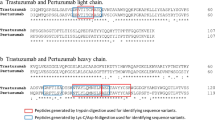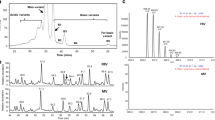Abstract
The development of sensitive techniques to detect sequence variants (SVs), which naturally arise due to DNA mutations and errors in transcription/translation (amino acid misincorporations), has resulted in increased attention to their potential presence in protein-based biologic drugs in recent years. Often, these SVs may be below 0.1 %, adding challenges for consistent and accurate detection. Furthermore, the presence of false-positive (FP) signals, a hallmark of SV analysis, requires time-consuming analyst inspection of the data to sort true from erroneous signal. Consequently, gaps in information about the prevalence, type, and impact of SVs in marketed and in-development products are significant. Here, we report the results of a simple, straightforward, and sensitive approach to sequence variant analysis. This strategy employs mixing of two samples of an antibody or protein with the same amino acid sequence in a dilution series followed by subsequent sequence variant analysis. Using automated peptide map analysis software, a quantitative assessment of the levels of SVs in each sample can be made based on the signal derived from the mass spectrometric data. We used this strategy to rapidly detect differences in sequence variants in a monoclonal antibody after a change in process scale, and in a comparison of three mAbs as part of a biosimilar program. This approach is powerful, as true signals can be readily distinguished from FP signal, even at a level well below 0.1 %, by using a simple linear regression analysis across the data set with none to minimal inspection of the MS/MS data. Additionally, the data produced from these studies can also be used to make a quantitative assessment of relative levels of product quality attributes. The information provided here extends the published knowledge about SVs and provides context for the discussion around the potential impact of these SVs on product heterogeneity and immunogenicity.

Histogram of 97 sequence variants detected in pilot and final scale mixing study of Antibody A. All Y>F adn Y>H sequence variants had an R2 value above 0.95, while several other sequence variants confirmed in both sample types had lower R2 values. The majority of false positive and unclassified sequence variants had R2 values below 0.3









Similar content being viewed by others
References
Scott RA, Rogers R, Balland A, Brady LJ (2014) Rapid identification of an antibody DNA construct rearrangement sequence variant by mass spectrometry. mAbs 6(6):1453–1463
Zhang T, Huang Y, Chamberlain S, Romeo T, Zhu-Shimoni J, Hewitt D, Zhu M, Katta V, Mauger B, Kao Y-H (2012) Identification of a single base-pair mutation of TAA (Stop codon) > GAA (Glu) that causes light chain extension in a CHO cell derived IgG1. mAbs 4(6):694–700
Meert C, Brady LJ, Guo A, Balland A (2010) Characterization of antibody charge heterogeneity resolved by preparative immobilized pH gradients. Anal Chem 82:3510–3518
Dorai H, Sauerwald T, Campbell A, Kyung YS, Goldstein J, Magill A, Lewis MJ, Tang QM, Jan D, Ganguly S (2007) Investigation of product microheterogeneity: a case study in rapid detection of mutation in mammalian production cell lines. Bioprocess Int 5(8):66
Harris RJ, Murnane AA, Utter SL, Wagner KLC ET, Polastri GD et al (1993) Assessing genetic heterogeneity in production cell lines: detection by peptide mapping of a low level Tyr to Gln sequence variant in a recombinant antibody. Nat Biotechnol 11:1293–1297
Feeney L, Carvalhal V, Yu XC, Chan B, Michels DA, Wang YJ, Shen A, Ressl J, Dusel B, Laird MW (2012) Eliminating tyrosine sequence variants in CHO cell lines producing recombinant monoclonal antibodies. Biotechnol Bioeng 110(4):1087–1097
Huang Y, O’mara B, Conover M, Ludwig R, Fu J, Tao L, Li ZJ, Rieble S, Grace MJ, Russell RJ (2012) Glycine to glutamic acid misincorporation observed in a recombinant protein expressed by Escherichia coli cells. Protein Sci 21:625–632
Khetan A, Y-m H, Dolnikova J, Pederson NE, Wen D, Yusef-Makagiansar CP, Ryll T (2010) Control of misincorporation of serine for asparagine during antibody production using CHO cells. Biotechnol Bioeng 107(1):116–123
Drummond DA, Wilke CO (2009) The evolutionary consequences of erroneous protein synthesis. Nat Genet 10:715–724
Yang Y, Strahan A, Li C, Shen A, Liu H, Ouyang J, Katta V, Francissen K, Zhang B (2010) Detecting low level sequence variants in recombinant monoclonal antibodies. mAbs 2(3):285–298
Bern M, Ki Y, Becker C (2012) Byonic: advanced peptide and protein identification software. Curr Protoc Bioinforma 40:13.20.1–13.20.14
Zhang Z (2009) Large-scale identification and quantification of covalent modifications in therapeutic proteins. Anal Chem 82(20):8354–8364
Zhang Z, Shah B, Bondarenko P (2013) G/U and certain wobble position mismatches as possible main causes of amino acid misincorporations. Biochemistry 52(45):8165–8176
Zeck A, Regula JT, Larraillet V, Mautz B, Popp O, Gopfert U, Wiegeshoff F, Vollertsen UEE, Gorr IH, Koll H et al (2012) Low level sequence variant analysis of recombinant proteins: an optimized approach. PLoS One 7(7):1–10
Fodor S, Zhang Z (2006) Rearrangement of terminal amino acid residues in peptides by protease-catalyzed intramolecular transpeptidation. Anal Biochem 356(2):282–290
Bi V, Jawa V, Jourbert M, Kaliyaperumal A, Eakin C, Richmond K, Pan O, Sun J, Hokom M, Goletz T et al (2013) Development of a human antibody tolerant mouse model to assess the immunogenicity risk due to aggregated biotherapeutics. J Pharm Sci 102:3545–3555
Ponce R, Abad L, Amaravadi L, Gelzleichter T, Gore E, Green J, Gupta S, Herzyk D, Hurst C, Ivens I et al (2009) Immunogenicity of biological-derived therapeutics: assessment and interpretation of nonclinical safety studies. Regul Toxicol Pharmacol 54:164–182
Acknowledgments
The authors would like to acknowledge the editorial input of Zhongqi Zhang (Amgen Product and Process Development), Gino Grampp (Amgen Strategic Planning and Operations), and Victor Fung (Amgen Biosimilar Business Unit) during the review of this paper.
Author information
Authors and Affiliations
Corresponding author
Additional information
Lowell J. Brady and Rebecca A. Scott contributed equally to this work.
Electronic supplementary material
Below is the link to the electronic supplementary material.
ESM 1
(PDF 78 kb)
Rights and permissions
About this article
Cite this article
Brady, L.J., Scott, R.A. & Balland, A. An optimized approach to the rapid assessment and detection of sequence variants in recombinant protein products. Anal Bioanal Chem 407, 3851–3860 (2015). https://doi.org/10.1007/s00216-015-8618-1
Received:
Revised:
Accepted:
Published:
Issue Date:
DOI: https://doi.org/10.1007/s00216-015-8618-1




